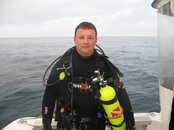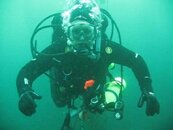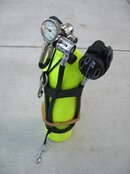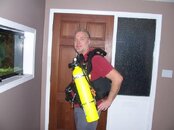I have honestly tried slinging the pony bottle on 6 of my dives this year and it did not work for me. It felt extremely awkward.
I love comments like "it did not work for me", especially where they relate to an approach which is universally adopted and taught consistently globally, and across each scuba agency. Slinging tanks does work - it works for much bigger tanks and also multiple tanks - that's why it is a universal approach for technical divers.
Might I make 2 suggestions?
1) 6 dives is probably insufficient time to get comfortable and proficient with the use of any new equipment, let alone a cumbersome redundant air cylinder.
2) Your attempts to 'teach yourself' are proving inefficient and costly. Why not invest some small time and expenditure in the appropriate training? A course such as Intro-to-Tech, Tech Basics, or even Tec40 would introduce you to the concept of diving 2-3 tanks in various configurations, and would show you effective methods to do so. It'd provide a spectrum of other benefits too. Such a course would have cost you less than your Spare Air contraption did - and unlike the Spare Air, probably won't inevitably end up in cobwebs under the stairs.
If you're insistent on the provision of ample redundant gas, you might also want to consider alternative approaches. Perhaps going to a set of doubles. In the UK, the use of small-capacity doubles (i.e twin-40's/7L tanks) has been popular for decades. If travel is a major factor then sidemount diving might be a very attractive option for you...again, with appropriately sized tanks for the dives you do.
Given your tribulations thus far, I recommend proper training as the method for learning new skills. Working it out for yourself wasn't a success. There's no stigma attached to that.... and getting the right training from the offset is a good means to lower your long-term costs, as it prevents wasted expenditure on pointless kit.
I have also tried attaching pony bottle across my lower stomach and it prevented me from having access to my weight belt which is a safety concern.
You won't see divers doing this, for many reasons. There's nothing wrong with experimentation, of course, but the configurations being suggested are tried and tested. If a particular configuration has been rejected by the scuba community, then it's probably for good reason. Ignoring the 'best practice' lessons harks towards a 'reinventing the wheel' - unnecessary.
I will not be switching over to DIN. I watch my dive trainer struggle with his setup (which always gets stuck after every dive) and in my 5 years of diving I see that DIN setup is not efficient unless you have your own DIN tanks. If you travel outside of country you have to rely on adapter which connects through yoke thus reducing efficiency of DIN setup just slightly.
Personally, seeing a 'dive trainer' struggle with basic equipment would give me serious cause for concern. Perhaps there is an underlying issue here...
DIN has pros and cons. When suggested as an improvement for your configuration, particularly the use of a pony cylinder, I am sure many people would assume that you
did own your own tank/s. Not many places rent pony cylinders, so that tank at least, could be improved by conversion to DIN.
I absolutely understand the cost issues involved. That said, it's important to recognize the difference between getting things right...or throwing good money after bad. You've spent a lot of money thus far and it hasn't worked out well for you.
Right when I first bought my pony bottle I already had about a year's worth of reading research from these forums on how people go about doing it.
Again, having researched, experimented and still struggling with your configuration after many months... it may be time to consider getting some expert advice at first-hand, rather than the internet. I'd suggest a competent technical instructor (one who doesn't "struggle with DIN valves")...
Problem is that I am 5ft 8in and weigh 145lbs so when I wore it it looked and felt as big as this:
Size doesn't preclude a configuration. There's plenty of small divers who comfortably carry
far more equipment than that, especially in the technical community. Technique, approach and familiarity are the issues... proper training/practical (not internet) advice is the solution.
In my case I have my video camera with me so pony used to interfere with me clipping camera back to BC when not in use, it also kind of got in the way if I ever had to reach for safe second. On top of it pony slightly offset my buoyancy. My right side would always want to sink so swimming at 10-20 degree angle got really old really fast.
You do realize that you aren't the first person to ever 'try' this?

Thousands... hundreds of thousands... of other divers manage to make it work... make it comfortable... make it safe.
Find a competent technical-level instructor and commit a day to learning from them. Allow them to help you configure and refine your equipment approach. The commit to getting comfortable with that approach in subsequent dives.
Your previous dalliances and experimentation do hark of 'excuse making', in lieu of a committed and informed approach to your equipment. It led you down a very wrong path. I think you need more than internet advice to resolve the problems you're experiencing.







